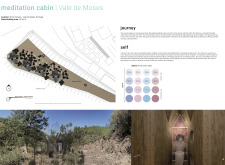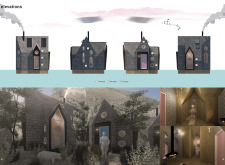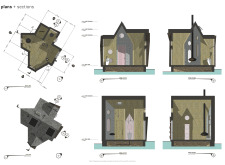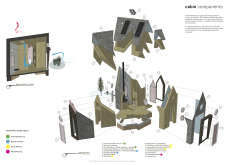5 key facts about this project
The design embodies a strong connection to the surrounding landscape, encouraging users to engage with their environment as part of their journey to the cabin. The approach to the building is intentionally meandering, inviting visitors to fully immerse in the natural setting. Upon arrival, the entrance features vibrant doors that act as welcoming thresholds, signaling the transition from the outside world into a more intimate, personal space.
In terms of layout, the Meditation Cabin exhibits a modular design, characterized by its hexagonal shape. This geometric approach facilitates fluid movement within the internal spaces, which include areas dedicated to relaxation and contemplation as well as a small storage room. The interior is organized to optimize the user experience, with special attention given to the interplay of light and space. Strategically placed windows and openings create a dynamic relationship between the interior and exterior, allowing natural light to filter in while maintaining privacy. This interaction encourages a sense of calm, making the space conducive to meditation and reflection.
Materiality is a significant aspect of the design, with a careful selection aimed at sustainability and harmony with the environment. Key materials include cross laminated timber, which not only offers structural stability but also contributes to the building's thermal efficiency. Wood shingles form the exterior, lending a rustic and natural aesthetic that complements the surrounding forest. Inside, a combination of treated and untreated wood finishing creates a warm atmosphere, enhancing the cabin's appeal as a retreat. Furthermore, the integration of glazed surfaces ensures that light can fill the interior, accentuating moments of tranquility while also allowing views of the picturesque landscape.
Unique design approaches are evident throughout the Meditation Cabin, particularly in the way the architecture navigates the balance between minimalism and environmental integration. The building utilizes varied opacities of walls that subtly divide spaces while maintaining an open feel—this thoughtful consideration allows for both privacy and connection to the outside world. Additionally, the use of solar panels showcases a commitment to renewable energy, ensuring that the cabin operates independently and sustainably.
The architectural design does not merely focus on aesthetics but also on creating an environment that promotes mindfulness. By facilitating a seamless blend of interior and exterior, the cabin enhances the user’s experience through an engaged connection with nature. This deliberate design outcome invites individuals to pause, reflect, and explore their inner selves, reinforcing the cabin’s role as a sanctuary.
For those interested in further exploring this architectural project, the presentation of the Meditation Cabin includes detailed architectural plans and sections, offering deeper insights into the design strategies and elements employed. By examining these aspects, one can appreciate the thoughtful architectural ideas that bring the cabin to life, showcasing a dedication to both functionality and aesthetics in a harmonious natural context.


























